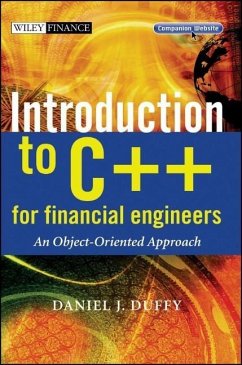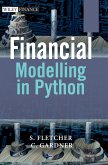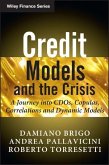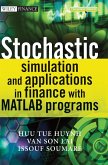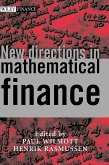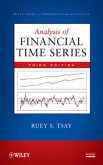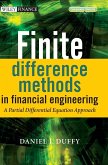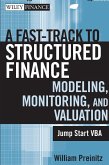- Gebundenes Buch
- Merkliste
- Auf die Merkliste
- Bewerten Bewerten
- Teilen
- Produkt teilen
- Produkterinnerung
- Produkterinnerung
The object-oriented programming language C++ is the de facto standard for developing real-life applications for Quantitative Finance and Financial Engineering. This language was designed by Dr. Bjarne Stroustup in the early 1990's and it has become one of the most popular and robust languages for many important areas such as medical systems, computer graphics, telecommunications and in application areas where performance, accuracy and interoperability issues play a key role. The general expectation is that its importance will grow in the coming years.
C++ has also become the de facto…mehr
Andere Kunden interessierten sich auch für
![Financial Modelling with Pytho Financial Modelling with Pytho]() Shayne FletcherFinancial Modelling with Pytho134,99 €
Shayne FletcherFinancial Modelling with Pytho134,99 €![Credit Models and the Crisis Credit Models and the Crisis]() Damiano BrigoCredit Models and the Crisis62,99 €
Damiano BrigoCredit Models and the Crisis62,99 €![Stochastic Simulation and Applications in Finance with MATLAB Programs Stochastic Simulation and Applications in Finance with MATLAB Programs]() Huu Tue HuynhStochastic Simulation and Applications in Finance with MATLAB Programs124,99 €
Huu Tue HuynhStochastic Simulation and Applications in Finance with MATLAB Programs124,99 €![New Directions in Mathematical Finance New Directions in Mathematical Finance]() Paul Wilmott / Henrik Rasmussen (Hgg.)New Directions in Mathematical Finance142,99 €
Paul Wilmott / Henrik Rasmussen (Hgg.)New Directions in Mathematical Finance142,99 €![Analysis of Financial Time Series Analysis of Financial Time Series]() Ruey S. TsayAnalysis of Financial Time Series144,99 €
Ruey S. TsayAnalysis of Financial Time Series144,99 €![Finite Difference Methods in Financial Engineering Finite Difference Methods in Financial Engineering]() Daniel J. DuffyFinite Difference Methods in Financial Engineering127,99 €
Daniel J. DuffyFinite Difference Methods in Financial Engineering127,99 €![A Fast Track to Structured Finance Modeling, Monitoring, and Valuation A Fast Track to Structured Finance Modeling, Monitoring, and Valuation]() William PreinitzA Fast Track to Structured Finance Modeling, Monitoring, and Valuation84,99 €
William PreinitzA Fast Track to Structured Finance Modeling, Monitoring, and Valuation84,99 €-
-
-
The object-oriented programming language C++ is the de facto standard for developing real-life applications for Quantitative Finance and Financial Engineering. This language was designed by Dr. Bjarne Stroustup in the early 1990's and it has become one of the most popular and robust languages for many important areas such as medical systems, computer graphics, telecommunications and in application areas where performance, accuracy and interoperability issues play a key role. The general expectation is that its importance will grow in the coming years.
C++ has also become the de facto standard for quant development and analysis. Knowledge of C++ is mandatory for many openings and job positions in Quantitative Finance. This book is the first book that discusses many of the issues that you need to know in order to be able to design and implement real-world applications. We focus on a number of critical topics:
_ Learning the essential syntax of C++ ('getting the fundamentals right')
_ Designing and implementing generic data structures using STL
_ Numerous applications (lattices, finite difference, Monte Carlo, etc)
_ Libraries, design patterns (GOF, POSA) and reusable software frameworks
_ Introduction to COM and C++ to Excel interoperability
Each chapter deals with one major topic. Furthermore, each chapter builds only on the results of the chapters preceding it, so that we keep the amount of forward referencing to a minimum. We discuss all the syntax that is discussed in the IT books and we apply it to QF applications. This book is self-contained and we advise its use in combination with the well-known standard reference work by Dr. Stroustrup.
Last, but not least, each chapter concludes with exercises and projects to test what you learned in that chapter. The exercises are based on the tactic: 'get it working, then get it right, then get it optimised'. Furthermore, these exercises will also hopefully prepare you for your job interviews!
Included with the book is a CD will full source code, including working code for lattice, finite difference and Monte Carlo methods for one-factor and two-factor pricing models as well as an easy-to-use C++ visualization package to help you examine the output from these numerical methods.
C++ has also become the de facto standard for quant development and analysis. Knowledge of C++ is mandatory for many openings and job positions in Quantitative Finance. This book is the first book that discusses many of the issues that you need to know in order to be able to design and implement real-world applications. We focus on a number of critical topics:
_ Learning the essential syntax of C++ ('getting the fundamentals right')
_ Designing and implementing generic data structures using STL
_ Numerous applications (lattices, finite difference, Monte Carlo, etc)
_ Libraries, design patterns (GOF, POSA) and reusable software frameworks
_ Introduction to COM and C++ to Excel interoperability
Each chapter deals with one major topic. Furthermore, each chapter builds only on the results of the chapters preceding it, so that we keep the amount of forward referencing to a minimum. We discuss all the syntax that is discussed in the IT books and we apply it to QF applications. This book is self-contained and we advise its use in combination with the well-known standard reference work by Dr. Stroustrup.
Last, but not least, each chapter concludes with exercises and projects to test what you learned in that chapter. The exercises are based on the tactic: 'get it working, then get it right, then get it optimised'. Furthermore, these exercises will also hopefully prepare you for your job interviews!
Included with the book is a CD will full source code, including working code for lattice, finite difference and Monte Carlo methods for one-factor and two-factor pricing models as well as an easy-to-use C++ visualization package to help you examine the output from these numerical methods.
Produktdetails
- Produktdetails
- Wiley Finance Series
- Verlag: Wiley & Sons
- 1. Auflage
- Seitenzahl: 438
- Erscheinungstermin: 1. Dezember 2006
- Englisch
- Abmessung: 258mm x 177mm x 34mm
- Gewicht: 1015g
- ISBN-13: 9780470015384
- ISBN-10: 0470015381
- Artikelnr.: 15164381
- Herstellerkennzeichnung
- Libri GmbH
- Europaallee 1
- 36244 Bad Hersfeld
- gpsr@libri.de
- Wiley Finance Series
- Verlag: Wiley & Sons
- 1. Auflage
- Seitenzahl: 438
- Erscheinungstermin: 1. Dezember 2006
- Englisch
- Abmessung: 258mm x 177mm x 34mm
- Gewicht: 1015g
- ISBN-13: 9780470015384
- ISBN-10: 0470015381
- Artikelnr.: 15164381
- Herstellerkennzeichnung
- Libri GmbH
- Europaallee 1
- 36244 Bad Hersfeld
- gpsr@libri.de
About the author DANIEL J. DUFFY has been involved in software development projects using C++ and object-oriented design techniques since 1988. He organized the first C++ course in the Netherlands in 1989 and has worked on a variety of C++ projects in areas such as computer graphics, optical technology, process control and quantitative finance systems. In 1993 he worked on an early version of a large object-oriented system for derivatives pricing and hedging models. He is designer/trainer and has trained more than 2000 C++ developers in recent years. A companion book to the current one is "Financial Instrument Pricing using C++" (Wiley 2004). Since 1996 he has written seven books on object-oriented design and programming. Daniel Duffy has a PhD in Numerical Analysis from Trinity College Dublin. He lives in the Netherlands with his wife Ilona and son Brendan. He can be contacted at dduffy@datasim.nl.
0 Goals of this Book and Global Overview 1
0.1 What is this book? 1
0.2 Why has this book been written? 1
0.3 For whom is this book intended? 2
0.4 Why should I read this book? 2
0.5 The structure of this book 2
0.6 What this book does not cover 2
0.7 More information and support 3
Part I C++ Essential Skills 5
1 Introduction to C++ and Quantitative Finance 7
1.1 Introduction and objectives 7
1.2 A short history of C++ 7
1.3 C++, a multi-paradigm language 8
1.4 C++ and quantitative finance: what's the relationship? 11
1.5 What is software quality? 11
1.6 Summary and conclusions 13
1.7 Exercises 14
2 The Mechanics of C++: from Source Code to a Running Program 15
2.1 Introduction and objectives 15
2.2 The compilation process 15
2.3 Header files and source files 16
2.4 Creating classes and using their objects 19
2.5 Template classes and template functions 22
2.6 Kinds of errors 25
2.7 The struct concept 27
2.8 Useful data conversion routines 27
2.9 Summary and conclusions 29
2.10 Exercises and projects 29
3 C++ Fundamentals and My First Option Class 31
3.1 Introduction and objectives 31
3.2 Class == member data + member functions 32
3.3 The header file (function prototypes) 33
3.4 The class body (code file) 35
3.5 Using the class 38
3.6 Examining the class in detail 40
3.7 Other paradigms 41
3.8 Summary and conclusions 45
3.9 Questions, exercises and projects 45
4 Creating Robust Classes 49
4.1 Introduction and objectives 49
4.2 Call by reference and call by value 49
4.3 Constant objects everywhere 52
4.4 Constructors in detail 54
4.5 Static member data and static member functions 55
4.6 Function overloading 57
4.7 Non-member functions 58
4.8 Performance tips and guidelines 58
4.9 Summary and conclusions 60
4.10 Questions, exercises and projects 60
5 Operator Overloading in C++ 63
5.1 Introduction and objectives 63
5.2 What is operator overloading and what are the possibilities? 63
5.3 Why use operator overloading? The advantages 65
5.4 Operator overloading: the steps 68
5.5 Using operator overloading for simple I/O 71
5.6 Friend functions in general 72
5.7 Summary and conclusions 74
5.8 Exercise 74
Appendix: useful data structures in C++ 75
6 Memory Management in C++ 79
6.1 Introduction and objectives 79
6.2 Single objects and arrays of objects on the stack 79
6.3 Special operators: 'new' and 'delete' 82
6.4 Small application: working with complex numbers 84
6.5 Creating an array class 86
6.6 Summary and conclusions 89
6.7 Exercises 89
6.8 Review questions and comments 91
7 Functions, Namespaces and Introduction to Inheritance 93
7.1 Introduction and objectives 93
7.2 Functions and function pointers 93
7.3 An introduction to namespaces in C++ 96
7.4 An introduction to the inheritance mechanism in C++ 99
7.5 Multiple inheritance 104
7.6 Solution of nonlinear equations 104
7.7 Nonlinear solvers in C++: design and implementation 106
7.8 Applying nonlinear solvers: calculating volatility 108
7.9 Summary and conclusions 109
7.10 Exercises and projects 109
8 Advanced Inheritance and Payoff Class Hierarchies 113
8.1 Introduction and objectives 113
8.2 The virtual specifier and memory deallocation 113
8.3 Abstract and concrete classes 115
8.4 Lightweight payoff classes 119
8.5 Super lightweight payoff functions 121
8.6 The dangers of inheritance: a counterexample 123
8.7 Implementation inheritance and fragile base class problem 127
8.8 Two-factor payoff functions and classes 127
8.9 Conclusions and summary 130
8.10 Exercises and projects 130
9 Run-Time Behaviour in C++ 133
9.1 Introduction and objectives 133
9.2 An introduction to reflection and self-aware objects 133
9.3 Run-time type information (RTTI) 134
9.4 Casting between types 137
9.5 Client-server programming and exception handling 140
9.6 try, throw and catch: ingredients of the C++ exception mechanism 141
9.7 C++ implementation 141
9.8 Pragmatic exception mechanisms 145
9.9 Conclusions and summary 149
9.10 Exercises and research 149
10 An Introduction to C++ Templates 153
10.1 Introduction and objectives 153
10.2 My first template class 154
10.3 Template functions 158
10.4 Consolidation: understanding templates 159
10.5 Summary and conclusions 163
10.6 Exercises and projects 164
Part II Data Structures, Templates and Patterns 167
11 Introduction to Generic Data Structures and Standard Template Library
(STL) 169
11.1 Introduction and objectives 169
11.2 Complexity analysis 170
11.3 An introduction to data structures 172
11.4 Algorithms 176
11.5 Navigation in data structures: iterators in STL 177
11.6 STL by example: my first example 178
11.7 Conclusions and summary 183
11.8 Exercises and projects 183
12 Creating Simpler Interfaces to STL for QF Applications 187
12.1 Introduction and objectives 187
12.2 Maps and dictionaries 187
12.3 Applications of maps 190
12.4 User-friendly sets 191
12.5 Associative arrays and associative matrices 196
12.6 Applications of associative data structures 199
12.7 Conclusions and summary 200
12.8 Exercises and projects 200
13 Data Structures for Financial Engineering Applications 203
13.1 Introduction and objectives 203
13.2 The property pattern 203
13.3 Property sets 205
13.4 Property sets and data modelling for quantitative finance 213
13.5 Lattice structures 215
13.6 Conclusions and summary 221
13.7 Exercises and projects 221
14 An Introduction to Design Patterns 223
14.1 Introduction and objectives 223
14.2 The software lifecycle 223
14.3 Documentation issues 225
14.4 An Introduction to design patterns 233
14.5 Are we using the wrong design? Choosing the appropriate pattern 237
14.6 CADObject, a C++ library for computer graphics 238
14.7 Using patterns in CADObject 241
14.8 Conclusions and summary 241
14.9 Exercises and projects 241
Part III QF Applications 243
15 Programming the Binomial Method in C++ 245
15.1 Introduction and objectives 245
15.2 Scoping the problem 246
15.3 A short overview of the binomial method 246
15.4 Software requirements for a binomial solver 249
15.5 Class design and class structure 250
15.6 Applying design patterns 252
15.7 The builder and director classes 255
15.8 The process and the steps 258
15.9 Test cases and examples 259
15.10 Conclusions and summary 260
15.11 Exercises and questions 260
16 Implementing One-Factor Black Scholes in C++ 265
16.1 Introduction and objectives 265
16.2 Scope and assumptions 265
16.3 Assembling the C++ building blocks 267
16.4 Modelling the black scholes PDE 267
16.5 Finite difference schemes 270
16.6 Test cases and presentation in excel 276
16.7 Summary 279
16.8 Exercises and projects 279
17 Two-Factor Option Pricing: Basket and Other Multi-Asset Options 283
17.1 Introduction and objectives 283
17.2 Motivation and background 283
17.3 Scoping the problem: PDEs for basket options 285
17.4 Modelling basket option PDE in UML and C++ 286
17.5 The finite difference method for two-factor problems 297
17.6 Discrete boundary and initial conditions 298
17.7 Assembling the system of equations 299
17.8 Post processing and output 301
17.9 Summary and conclusions 302
17.10 Exercises and projects 302
18 Useful C++ Classes for Numerical Analysis Applications in Finance 305
18.1 Introduction and objectives 305
18.2 Solving tridiagonal systems 305
18.3 An introduction to interpolation 310
18.4 Summary and conclusions 313
19 Other Numerical Methods in Quantitative Finance 315
19.1 Introduction and objectives 315
19.2 The trinomial method for assets 315
19.3 Lattice data structures 318
19.4 Trinomial tree for the short rate 318
19.5 The multidimensional binomial method 321
19.6 Generic lattice structures 322
19.7 Approximating exponential functions 326
19.8 Summary and conclusions 326
19.9 Exercises 326
20 The Monte Carlo Method Theory and C++ Frameworks 327
Dr. Joerg Kieritz and Daniel J. Duffy
20.1 Introduction and objectives 327
20.2 A short history of the Monte Carlo (MC) method 327
20.3 Examples of the application of the Monte Carlo method 327
20.4 The Monte Carlo method in quantitative finance 333
20.5 Software architecture for the Monte Carlo method 337
20.6 Examples and test cases 338
20.7 Summary and conclusions 340
20.8 Appendix: comparing Monte Carlo with other numerical methods 340
20.9 Exercises and projects 341
21 Skills Development: from White Belt to Black Belt 345
21.1 Introduction and objectives 345
21.2 Review of book 345
21.3 Part I: C++ essential skills 345
21.4 Part II: data structures, templates and patterns 346
21.5 Part III: applications in quantitative finance 347
21.6 Part IV: background information 347
21.7 Choosing a programming paradigm 348
21.8 Summary and conclusions 349
Part IV Background Information 351
22 Basic C Survival Guide 353
22.1 Introduction and objectives 353
22.2 Basic data types 353
22.3 The C preprocessor 354
22.4 Pointers and references 355
22.5 Other useful bits and pieces 357
22.6 What to avoid in c 357
22.7 Test case: numerical integration in one dimension 358
22.8 Conclusions and summary 359
22.9 Exercises 359
23 Advanced C Syntax 363
23.1 Introduction and objectives 363
23.2 Fixed-size and dynamic arrays 364
23.3 Multi-dimensional arrays 364
23.4 Introduction to structures 365
23.5 Unions 366
23.6 Useful C libraries 366
23.7 Test case: linear regression 367
23.8 Conclusions and summary 370
23.9 Exercises 370
24 Datasim Visualisation Package in Excel: Drivers and Mechanisms 373
24.1 Introduction and objectives 373
24.2 Fundamental functionality in the package 373
24.3 Basic driver functionality 373
24.4 Excel mechanisms 376
24.5 Option values and sensitivities in excel 380
24.6 Finite difference method 384
24.7 Summary and conclusions 387
24.8 Exercises and projects 387
25 Motivating COM and Emulation in C++ 391
25.1 Introduction and objectives 391
25.2 A short history of COM 391
25.3 An introduction to multiple inheritance (MI) 391
25.4 Interfaces and multiple inheritance 396
25.5 Virtual function tables 399
25.6 Summary 399
26 COM Fundamentals 401
26.1 Introduction and objectives 401
26.2 Interfaces in COM 401
26.3 The IUnknown interface 401
26.4 Using IUnknown 402
26.5 Defining new versions of components 406
26.6 Summary 406
References 407
Index 409
0.1 What is this book? 1
0.2 Why has this book been written? 1
0.3 For whom is this book intended? 2
0.4 Why should I read this book? 2
0.5 The structure of this book 2
0.6 What this book does not cover 2
0.7 More information and support 3
Part I C++ Essential Skills 5
1 Introduction to C++ and Quantitative Finance 7
1.1 Introduction and objectives 7
1.2 A short history of C++ 7
1.3 C++, a multi-paradigm language 8
1.4 C++ and quantitative finance: what's the relationship? 11
1.5 What is software quality? 11
1.6 Summary and conclusions 13
1.7 Exercises 14
2 The Mechanics of C++: from Source Code to a Running Program 15
2.1 Introduction and objectives 15
2.2 The compilation process 15
2.3 Header files and source files 16
2.4 Creating classes and using their objects 19
2.5 Template classes and template functions 22
2.6 Kinds of errors 25
2.7 The struct concept 27
2.8 Useful data conversion routines 27
2.9 Summary and conclusions 29
2.10 Exercises and projects 29
3 C++ Fundamentals and My First Option Class 31
3.1 Introduction and objectives 31
3.2 Class == member data + member functions 32
3.3 The header file (function prototypes) 33
3.4 The class body (code file) 35
3.5 Using the class 38
3.6 Examining the class in detail 40
3.7 Other paradigms 41
3.8 Summary and conclusions 45
3.9 Questions, exercises and projects 45
4 Creating Robust Classes 49
4.1 Introduction and objectives 49
4.2 Call by reference and call by value 49
4.3 Constant objects everywhere 52
4.4 Constructors in detail 54
4.5 Static member data and static member functions 55
4.6 Function overloading 57
4.7 Non-member functions 58
4.8 Performance tips and guidelines 58
4.9 Summary and conclusions 60
4.10 Questions, exercises and projects 60
5 Operator Overloading in C++ 63
5.1 Introduction and objectives 63
5.2 What is operator overloading and what are the possibilities? 63
5.3 Why use operator overloading? The advantages 65
5.4 Operator overloading: the steps 68
5.5 Using operator overloading for simple I/O 71
5.6 Friend functions in general 72
5.7 Summary and conclusions 74
5.8 Exercise 74
Appendix: useful data structures in C++ 75
6 Memory Management in C++ 79
6.1 Introduction and objectives 79
6.2 Single objects and arrays of objects on the stack 79
6.3 Special operators: 'new' and 'delete' 82
6.4 Small application: working with complex numbers 84
6.5 Creating an array class 86
6.6 Summary and conclusions 89
6.7 Exercises 89
6.8 Review questions and comments 91
7 Functions, Namespaces and Introduction to Inheritance 93
7.1 Introduction and objectives 93
7.2 Functions and function pointers 93
7.3 An introduction to namespaces in C++ 96
7.4 An introduction to the inheritance mechanism in C++ 99
7.5 Multiple inheritance 104
7.6 Solution of nonlinear equations 104
7.7 Nonlinear solvers in C++: design and implementation 106
7.8 Applying nonlinear solvers: calculating volatility 108
7.9 Summary and conclusions 109
7.10 Exercises and projects 109
8 Advanced Inheritance and Payoff Class Hierarchies 113
8.1 Introduction and objectives 113
8.2 The virtual specifier and memory deallocation 113
8.3 Abstract and concrete classes 115
8.4 Lightweight payoff classes 119
8.5 Super lightweight payoff functions 121
8.6 The dangers of inheritance: a counterexample 123
8.7 Implementation inheritance and fragile base class problem 127
8.8 Two-factor payoff functions and classes 127
8.9 Conclusions and summary 130
8.10 Exercises and projects 130
9 Run-Time Behaviour in C++ 133
9.1 Introduction and objectives 133
9.2 An introduction to reflection and self-aware objects 133
9.3 Run-time type information (RTTI) 134
9.4 Casting between types 137
9.5 Client-server programming and exception handling 140
9.6 try, throw and catch: ingredients of the C++ exception mechanism 141
9.7 C++ implementation 141
9.8 Pragmatic exception mechanisms 145
9.9 Conclusions and summary 149
9.10 Exercises and research 149
10 An Introduction to C++ Templates 153
10.1 Introduction and objectives 153
10.2 My first template class 154
10.3 Template functions 158
10.4 Consolidation: understanding templates 159
10.5 Summary and conclusions 163
10.6 Exercises and projects 164
Part II Data Structures, Templates and Patterns 167
11 Introduction to Generic Data Structures and Standard Template Library
(STL) 169
11.1 Introduction and objectives 169
11.2 Complexity analysis 170
11.3 An introduction to data structures 172
11.4 Algorithms 176
11.5 Navigation in data structures: iterators in STL 177
11.6 STL by example: my first example 178
11.7 Conclusions and summary 183
11.8 Exercises and projects 183
12 Creating Simpler Interfaces to STL for QF Applications 187
12.1 Introduction and objectives 187
12.2 Maps and dictionaries 187
12.3 Applications of maps 190
12.4 User-friendly sets 191
12.5 Associative arrays and associative matrices 196
12.6 Applications of associative data structures 199
12.7 Conclusions and summary 200
12.8 Exercises and projects 200
13 Data Structures for Financial Engineering Applications 203
13.1 Introduction and objectives 203
13.2 The property pattern 203
13.3 Property sets 205
13.4 Property sets and data modelling for quantitative finance 213
13.5 Lattice structures 215
13.6 Conclusions and summary 221
13.7 Exercises and projects 221
14 An Introduction to Design Patterns 223
14.1 Introduction and objectives 223
14.2 The software lifecycle 223
14.3 Documentation issues 225
14.4 An Introduction to design patterns 233
14.5 Are we using the wrong design? Choosing the appropriate pattern 237
14.6 CADObject, a C++ library for computer graphics 238
14.7 Using patterns in CADObject 241
14.8 Conclusions and summary 241
14.9 Exercises and projects 241
Part III QF Applications 243
15 Programming the Binomial Method in C++ 245
15.1 Introduction and objectives 245
15.2 Scoping the problem 246
15.3 A short overview of the binomial method 246
15.4 Software requirements for a binomial solver 249
15.5 Class design and class structure 250
15.6 Applying design patterns 252
15.7 The builder and director classes 255
15.8 The process and the steps 258
15.9 Test cases and examples 259
15.10 Conclusions and summary 260
15.11 Exercises and questions 260
16 Implementing One-Factor Black Scholes in C++ 265
16.1 Introduction and objectives 265
16.2 Scope and assumptions 265
16.3 Assembling the C++ building blocks 267
16.4 Modelling the black scholes PDE 267
16.5 Finite difference schemes 270
16.6 Test cases and presentation in excel 276
16.7 Summary 279
16.8 Exercises and projects 279
17 Two-Factor Option Pricing: Basket and Other Multi-Asset Options 283
17.1 Introduction and objectives 283
17.2 Motivation and background 283
17.3 Scoping the problem: PDEs for basket options 285
17.4 Modelling basket option PDE in UML and C++ 286
17.5 The finite difference method for two-factor problems 297
17.6 Discrete boundary and initial conditions 298
17.7 Assembling the system of equations 299
17.8 Post processing and output 301
17.9 Summary and conclusions 302
17.10 Exercises and projects 302
18 Useful C++ Classes for Numerical Analysis Applications in Finance 305
18.1 Introduction and objectives 305
18.2 Solving tridiagonal systems 305
18.3 An introduction to interpolation 310
18.4 Summary and conclusions 313
19 Other Numerical Methods in Quantitative Finance 315
19.1 Introduction and objectives 315
19.2 The trinomial method for assets 315
19.3 Lattice data structures 318
19.4 Trinomial tree for the short rate 318
19.5 The multidimensional binomial method 321
19.6 Generic lattice structures 322
19.7 Approximating exponential functions 326
19.8 Summary and conclusions 326
19.9 Exercises 326
20 The Monte Carlo Method Theory and C++ Frameworks 327
Dr. Joerg Kieritz and Daniel J. Duffy
20.1 Introduction and objectives 327
20.2 A short history of the Monte Carlo (MC) method 327
20.3 Examples of the application of the Monte Carlo method 327
20.4 The Monte Carlo method in quantitative finance 333
20.5 Software architecture for the Monte Carlo method 337
20.6 Examples and test cases 338
20.7 Summary and conclusions 340
20.8 Appendix: comparing Monte Carlo with other numerical methods 340
20.9 Exercises and projects 341
21 Skills Development: from White Belt to Black Belt 345
21.1 Introduction and objectives 345
21.2 Review of book 345
21.3 Part I: C++ essential skills 345
21.4 Part II: data structures, templates and patterns 346
21.5 Part III: applications in quantitative finance 347
21.6 Part IV: background information 347
21.7 Choosing a programming paradigm 348
21.8 Summary and conclusions 349
Part IV Background Information 351
22 Basic C Survival Guide 353
22.1 Introduction and objectives 353
22.2 Basic data types 353
22.3 The C preprocessor 354
22.4 Pointers and references 355
22.5 Other useful bits and pieces 357
22.6 What to avoid in c 357
22.7 Test case: numerical integration in one dimension 358
22.8 Conclusions and summary 359
22.9 Exercises 359
23 Advanced C Syntax 363
23.1 Introduction and objectives 363
23.2 Fixed-size and dynamic arrays 364
23.3 Multi-dimensional arrays 364
23.4 Introduction to structures 365
23.5 Unions 366
23.6 Useful C libraries 366
23.7 Test case: linear regression 367
23.8 Conclusions and summary 370
23.9 Exercises 370
24 Datasim Visualisation Package in Excel: Drivers and Mechanisms 373
24.1 Introduction and objectives 373
24.2 Fundamental functionality in the package 373
24.3 Basic driver functionality 373
24.4 Excel mechanisms 376
24.5 Option values and sensitivities in excel 380
24.6 Finite difference method 384
24.7 Summary and conclusions 387
24.8 Exercises and projects 387
25 Motivating COM and Emulation in C++ 391
25.1 Introduction and objectives 391
25.2 A short history of COM 391
25.3 An introduction to multiple inheritance (MI) 391
25.4 Interfaces and multiple inheritance 396
25.5 Virtual function tables 399
25.6 Summary 399
26 COM Fundamentals 401
26.1 Introduction and objectives 401
26.2 Interfaces in COM 401
26.3 The IUnknown interface 401
26.4 Using IUnknown 402
26.5 Defining new versions of components 406
26.6 Summary 406
References 407
Index 409
0 Goals of this Book and Global Overview 1
0.1 What is this book? 1
0.2 Why has this book been written? 1
0.3 For whom is this book intended? 2
0.4 Why should I read this book? 2
0.5 The structure of this book 2
0.6 What this book does not cover 2
0.7 More information and support 3
Part I C++ Essential Skills 5
1 Introduction to C++ and Quantitative Finance 7
1.1 Introduction and objectives 7
1.2 A short history of C++ 7
1.3 C++, a multi-paradigm language 8
1.4 C++ and quantitative finance: what's the relationship? 11
1.5 What is software quality? 11
1.6 Summary and conclusions 13
1.7 Exercises 14
2 The Mechanics of C++: from Source Code to a Running Program 15
2.1 Introduction and objectives 15
2.2 The compilation process 15
2.3 Header files and source files 16
2.4 Creating classes and using their objects 19
2.5 Template classes and template functions 22
2.6 Kinds of errors 25
2.7 The struct concept 27
2.8 Useful data conversion routines 27
2.9 Summary and conclusions 29
2.10 Exercises and projects 29
3 C++ Fundamentals and My First Option Class 31
3.1 Introduction and objectives 31
3.2 Class == member data + member functions 32
3.3 The header file (function prototypes) 33
3.4 The class body (code file) 35
3.5 Using the class 38
3.6 Examining the class in detail 40
3.7 Other paradigms 41
3.8 Summary and conclusions 45
3.9 Questions, exercises and projects 45
4 Creating Robust Classes 49
4.1 Introduction and objectives 49
4.2 Call by reference and call by value 49
4.3 Constant objects everywhere 52
4.4 Constructors in detail 54
4.5 Static member data and static member functions 55
4.6 Function overloading 57
4.7 Non-member functions 58
4.8 Performance tips and guidelines 58
4.9 Summary and conclusions 60
4.10 Questions, exercises and projects 60
5 Operator Overloading in C++ 63
5.1 Introduction and objectives 63
5.2 What is operator overloading and what are the possibilities? 63
5.3 Why use operator overloading? The advantages 65
5.4 Operator overloading: the steps 68
5.5 Using operator overloading for simple I/O 71
5.6 Friend functions in general 72
5.7 Summary and conclusions 74
5.8 Exercise 74
Appendix: useful data structures in C++ 75
6 Memory Management in C++ 79
6.1 Introduction and objectives 79
6.2 Single objects and arrays of objects on the stack 79
6.3 Special operators: 'new' and 'delete' 82
6.4 Small application: working with complex numbers 84
6.5 Creating an array class 86
6.6 Summary and conclusions 89
6.7 Exercises 89
6.8 Review questions and comments 91
7 Functions, Namespaces and Introduction to Inheritance 93
7.1 Introduction and objectives 93
7.2 Functions and function pointers 93
7.3 An introduction to namespaces in C++ 96
7.4 An introduction to the inheritance mechanism in C++ 99
7.5 Multiple inheritance 104
7.6 Solution of nonlinear equations 104
7.7 Nonlinear solvers in C++: design and implementation 106
7.8 Applying nonlinear solvers: calculating volatility 108
7.9 Summary and conclusions 109
7.10 Exercises and projects 109
8 Advanced Inheritance and Payoff Class Hierarchies 113
8.1 Introduction and objectives 113
8.2 The virtual specifier and memory deallocation 113
8.3 Abstract and concrete classes 115
8.4 Lightweight payoff classes 119
8.5 Super lightweight payoff functions 121
8.6 The dangers of inheritance: a counterexample 123
8.7 Implementation inheritance and fragile base class problem 127
8.8 Two-factor payoff functions and classes 127
8.9 Conclusions and summary 130
8.10 Exercises and projects 130
9 Run-Time Behaviour in C++ 133
9.1 Introduction and objectives 133
9.2 An introduction to reflection and self-aware objects 133
9.3 Run-time type information (RTTI) 134
9.4 Casting between types 137
9.5 Client-server programming and exception handling 140
9.6 try, throw and catch: ingredients of the C++ exception mechanism 141
9.7 C++ implementation 141
9.8 Pragmatic exception mechanisms 145
9.9 Conclusions and summary 149
9.10 Exercises and research 149
10 An Introduction to C++ Templates 153
10.1 Introduction and objectives 153
10.2 My first template class 154
10.3 Template functions 158
10.4 Consolidation: understanding templates 159
10.5 Summary and conclusions 163
10.6 Exercises and projects 164
Part II Data Structures, Templates and Patterns 167
11 Introduction to Generic Data Structures and Standard Template Library
(STL) 169
11.1 Introduction and objectives 169
11.2 Complexity analysis 170
11.3 An introduction to data structures 172
11.4 Algorithms 176
11.5 Navigation in data structures: iterators in STL 177
11.6 STL by example: my first example 178
11.7 Conclusions and summary 183
11.8 Exercises and projects 183
12 Creating Simpler Interfaces to STL for QF Applications 187
12.1 Introduction and objectives 187
12.2 Maps and dictionaries 187
12.3 Applications of maps 190
12.4 User-friendly sets 191
12.5 Associative arrays and associative matrices 196
12.6 Applications of associative data structures 199
12.7 Conclusions and summary 200
12.8 Exercises and projects 200
13 Data Structures for Financial Engineering Applications 203
13.1 Introduction and objectives 203
13.2 The property pattern 203
13.3 Property sets 205
13.4 Property sets and data modelling for quantitative finance 213
13.5 Lattice structures 215
13.6 Conclusions and summary 221
13.7 Exercises and projects 221
14 An Introduction to Design Patterns 223
14.1 Introduction and objectives 223
14.2 The software lifecycle 223
14.3 Documentation issues 225
14.4 An Introduction to design patterns 233
14.5 Are we using the wrong design? Choosing the appropriate pattern 237
14.6 CADObject, a C++ library for computer graphics 238
14.7 Using patterns in CADObject 241
14.8 Conclusions and summary 241
14.9 Exercises and projects 241
Part III QF Applications 243
15 Programming the Binomial Method in C++ 245
15.1 Introduction and objectives 245
15.2 Scoping the problem 246
15.3 A short overview of the binomial method 246
15.4 Software requirements for a binomial solver 249
15.5 Class design and class structure 250
15.6 Applying design patterns 252
15.7 The builder and director classes 255
15.8 The process and the steps 258
15.9 Test cases and examples 259
15.10 Conclusions and summary 260
15.11 Exercises and questions 260
16 Implementing One-Factor Black Scholes in C++ 265
16.1 Introduction and objectives 265
16.2 Scope and assumptions 265
16.3 Assembling the C++ building blocks 267
16.4 Modelling the black scholes PDE 267
16.5 Finite difference schemes 270
16.6 Test cases and presentation in excel 276
16.7 Summary 279
16.8 Exercises and projects 279
17 Two-Factor Option Pricing: Basket and Other Multi-Asset Options 283
17.1 Introduction and objectives 283
17.2 Motivation and background 283
17.3 Scoping the problem: PDEs for basket options 285
17.4 Modelling basket option PDE in UML and C++ 286
17.5 The finite difference method for two-factor problems 297
17.6 Discrete boundary and initial conditions 298
17.7 Assembling the system of equations 299
17.8 Post processing and output 301
17.9 Summary and conclusions 302
17.10 Exercises and projects 302
18 Useful C++ Classes for Numerical Analysis Applications in Finance 305
18.1 Introduction and objectives 305
18.2 Solving tridiagonal systems 305
18.3 An introduction to interpolation 310
18.4 Summary and conclusions 313
19 Other Numerical Methods in Quantitative Finance 315
19.1 Introduction and objectives 315
19.2 The trinomial method for assets 315
19.3 Lattice data structures 318
19.4 Trinomial tree for the short rate 318
19.5 The multidimensional binomial method 321
19.6 Generic lattice structures 322
19.7 Approximating exponential functions 326
19.8 Summary and conclusions 326
19.9 Exercises 326
20 The Monte Carlo Method Theory and C++ Frameworks 327
Dr. Joerg Kieritz and Daniel J. Duffy
20.1 Introduction and objectives 327
20.2 A short history of the Monte Carlo (MC) method 327
20.3 Examples of the application of the Monte Carlo method 327
20.4 The Monte Carlo method in quantitative finance 333
20.5 Software architecture for the Monte Carlo method 337
20.6 Examples and test cases 338
20.7 Summary and conclusions 340
20.8 Appendix: comparing Monte Carlo with other numerical methods 340
20.9 Exercises and projects 341
21 Skills Development: from White Belt to Black Belt 345
21.1 Introduction and objectives 345
21.2 Review of book 345
21.3 Part I: C++ essential skills 345
21.4 Part II: data structures, templates and patterns 346
21.5 Part III: applications in quantitative finance 347
21.6 Part IV: background information 347
21.7 Choosing a programming paradigm 348
21.8 Summary and conclusions 349
Part IV Background Information 351
22 Basic C Survival Guide 353
22.1 Introduction and objectives 353
22.2 Basic data types 353
22.3 The C preprocessor 354
22.4 Pointers and references 355
22.5 Other useful bits and pieces 357
22.6 What to avoid in c 357
22.7 Test case: numerical integration in one dimension 358
22.8 Conclusions and summary 359
22.9 Exercises 359
23 Advanced C Syntax 363
23.1 Introduction and objectives 363
23.2 Fixed-size and dynamic arrays 364
23.3 Multi-dimensional arrays 364
23.4 Introduction to structures 365
23.5 Unions 366
23.6 Useful C libraries 366
23.7 Test case: linear regression 367
23.8 Conclusions and summary 370
23.9 Exercises 370
24 Datasim Visualisation Package in Excel: Drivers and Mechanisms 373
24.1 Introduction and objectives 373
24.2 Fundamental functionality in the package 373
24.3 Basic driver functionality 373
24.4 Excel mechanisms 376
24.5 Option values and sensitivities in excel 380
24.6 Finite difference method 384
24.7 Summary and conclusions 387
24.8 Exercises and projects 387
25 Motivating COM and Emulation in C++ 391
25.1 Introduction and objectives 391
25.2 A short history of COM 391
25.3 An introduction to multiple inheritance (MI) 391
25.4 Interfaces and multiple inheritance 396
25.5 Virtual function tables 399
25.6 Summary 399
26 COM Fundamentals 401
26.1 Introduction and objectives 401
26.2 Interfaces in COM 401
26.3 The IUnknown interface 401
26.4 Using IUnknown 402
26.5 Defining new versions of components 406
26.6 Summary 406
References 407
Index 409
0.1 What is this book? 1
0.2 Why has this book been written? 1
0.3 For whom is this book intended? 2
0.4 Why should I read this book? 2
0.5 The structure of this book 2
0.6 What this book does not cover 2
0.7 More information and support 3
Part I C++ Essential Skills 5
1 Introduction to C++ and Quantitative Finance 7
1.1 Introduction and objectives 7
1.2 A short history of C++ 7
1.3 C++, a multi-paradigm language 8
1.4 C++ and quantitative finance: what's the relationship? 11
1.5 What is software quality? 11
1.6 Summary and conclusions 13
1.7 Exercises 14
2 The Mechanics of C++: from Source Code to a Running Program 15
2.1 Introduction and objectives 15
2.2 The compilation process 15
2.3 Header files and source files 16
2.4 Creating classes and using their objects 19
2.5 Template classes and template functions 22
2.6 Kinds of errors 25
2.7 The struct concept 27
2.8 Useful data conversion routines 27
2.9 Summary and conclusions 29
2.10 Exercises and projects 29
3 C++ Fundamentals and My First Option Class 31
3.1 Introduction and objectives 31
3.2 Class == member data + member functions 32
3.3 The header file (function prototypes) 33
3.4 The class body (code file) 35
3.5 Using the class 38
3.6 Examining the class in detail 40
3.7 Other paradigms 41
3.8 Summary and conclusions 45
3.9 Questions, exercises and projects 45
4 Creating Robust Classes 49
4.1 Introduction and objectives 49
4.2 Call by reference and call by value 49
4.3 Constant objects everywhere 52
4.4 Constructors in detail 54
4.5 Static member data and static member functions 55
4.6 Function overloading 57
4.7 Non-member functions 58
4.8 Performance tips and guidelines 58
4.9 Summary and conclusions 60
4.10 Questions, exercises and projects 60
5 Operator Overloading in C++ 63
5.1 Introduction and objectives 63
5.2 What is operator overloading and what are the possibilities? 63
5.3 Why use operator overloading? The advantages 65
5.4 Operator overloading: the steps 68
5.5 Using operator overloading for simple I/O 71
5.6 Friend functions in general 72
5.7 Summary and conclusions 74
5.8 Exercise 74
Appendix: useful data structures in C++ 75
6 Memory Management in C++ 79
6.1 Introduction and objectives 79
6.2 Single objects and arrays of objects on the stack 79
6.3 Special operators: 'new' and 'delete' 82
6.4 Small application: working with complex numbers 84
6.5 Creating an array class 86
6.6 Summary and conclusions 89
6.7 Exercises 89
6.8 Review questions and comments 91
7 Functions, Namespaces and Introduction to Inheritance 93
7.1 Introduction and objectives 93
7.2 Functions and function pointers 93
7.3 An introduction to namespaces in C++ 96
7.4 An introduction to the inheritance mechanism in C++ 99
7.5 Multiple inheritance 104
7.6 Solution of nonlinear equations 104
7.7 Nonlinear solvers in C++: design and implementation 106
7.8 Applying nonlinear solvers: calculating volatility 108
7.9 Summary and conclusions 109
7.10 Exercises and projects 109
8 Advanced Inheritance and Payoff Class Hierarchies 113
8.1 Introduction and objectives 113
8.2 The virtual specifier and memory deallocation 113
8.3 Abstract and concrete classes 115
8.4 Lightweight payoff classes 119
8.5 Super lightweight payoff functions 121
8.6 The dangers of inheritance: a counterexample 123
8.7 Implementation inheritance and fragile base class problem 127
8.8 Two-factor payoff functions and classes 127
8.9 Conclusions and summary 130
8.10 Exercises and projects 130
9 Run-Time Behaviour in C++ 133
9.1 Introduction and objectives 133
9.2 An introduction to reflection and self-aware objects 133
9.3 Run-time type information (RTTI) 134
9.4 Casting between types 137
9.5 Client-server programming and exception handling 140
9.6 try, throw and catch: ingredients of the C++ exception mechanism 141
9.7 C++ implementation 141
9.8 Pragmatic exception mechanisms 145
9.9 Conclusions and summary 149
9.10 Exercises and research 149
10 An Introduction to C++ Templates 153
10.1 Introduction and objectives 153
10.2 My first template class 154
10.3 Template functions 158
10.4 Consolidation: understanding templates 159
10.5 Summary and conclusions 163
10.6 Exercises and projects 164
Part II Data Structures, Templates and Patterns 167
11 Introduction to Generic Data Structures and Standard Template Library
(STL) 169
11.1 Introduction and objectives 169
11.2 Complexity analysis 170
11.3 An introduction to data structures 172
11.4 Algorithms 176
11.5 Navigation in data structures: iterators in STL 177
11.6 STL by example: my first example 178
11.7 Conclusions and summary 183
11.8 Exercises and projects 183
12 Creating Simpler Interfaces to STL for QF Applications 187
12.1 Introduction and objectives 187
12.2 Maps and dictionaries 187
12.3 Applications of maps 190
12.4 User-friendly sets 191
12.5 Associative arrays and associative matrices 196
12.6 Applications of associative data structures 199
12.7 Conclusions and summary 200
12.8 Exercises and projects 200
13 Data Structures for Financial Engineering Applications 203
13.1 Introduction and objectives 203
13.2 The property pattern 203
13.3 Property sets 205
13.4 Property sets and data modelling for quantitative finance 213
13.5 Lattice structures 215
13.6 Conclusions and summary 221
13.7 Exercises and projects 221
14 An Introduction to Design Patterns 223
14.1 Introduction and objectives 223
14.2 The software lifecycle 223
14.3 Documentation issues 225
14.4 An Introduction to design patterns 233
14.5 Are we using the wrong design? Choosing the appropriate pattern 237
14.6 CADObject, a C++ library for computer graphics 238
14.7 Using patterns in CADObject 241
14.8 Conclusions and summary 241
14.9 Exercises and projects 241
Part III QF Applications 243
15 Programming the Binomial Method in C++ 245
15.1 Introduction and objectives 245
15.2 Scoping the problem 246
15.3 A short overview of the binomial method 246
15.4 Software requirements for a binomial solver 249
15.5 Class design and class structure 250
15.6 Applying design patterns 252
15.7 The builder and director classes 255
15.8 The process and the steps 258
15.9 Test cases and examples 259
15.10 Conclusions and summary 260
15.11 Exercises and questions 260
16 Implementing One-Factor Black Scholes in C++ 265
16.1 Introduction and objectives 265
16.2 Scope and assumptions 265
16.3 Assembling the C++ building blocks 267
16.4 Modelling the black scholes PDE 267
16.5 Finite difference schemes 270
16.6 Test cases and presentation in excel 276
16.7 Summary 279
16.8 Exercises and projects 279
17 Two-Factor Option Pricing: Basket and Other Multi-Asset Options 283
17.1 Introduction and objectives 283
17.2 Motivation and background 283
17.3 Scoping the problem: PDEs for basket options 285
17.4 Modelling basket option PDE in UML and C++ 286
17.5 The finite difference method for two-factor problems 297
17.6 Discrete boundary and initial conditions 298
17.7 Assembling the system of equations 299
17.8 Post processing and output 301
17.9 Summary and conclusions 302
17.10 Exercises and projects 302
18 Useful C++ Classes for Numerical Analysis Applications in Finance 305
18.1 Introduction and objectives 305
18.2 Solving tridiagonal systems 305
18.3 An introduction to interpolation 310
18.4 Summary and conclusions 313
19 Other Numerical Methods in Quantitative Finance 315
19.1 Introduction and objectives 315
19.2 The trinomial method for assets 315
19.3 Lattice data structures 318
19.4 Trinomial tree for the short rate 318
19.5 The multidimensional binomial method 321
19.6 Generic lattice structures 322
19.7 Approximating exponential functions 326
19.8 Summary and conclusions 326
19.9 Exercises 326
20 The Monte Carlo Method Theory and C++ Frameworks 327
Dr. Joerg Kieritz and Daniel J. Duffy
20.1 Introduction and objectives 327
20.2 A short history of the Monte Carlo (MC) method 327
20.3 Examples of the application of the Monte Carlo method 327
20.4 The Monte Carlo method in quantitative finance 333
20.5 Software architecture for the Monte Carlo method 337
20.6 Examples and test cases 338
20.7 Summary and conclusions 340
20.8 Appendix: comparing Monte Carlo with other numerical methods 340
20.9 Exercises and projects 341
21 Skills Development: from White Belt to Black Belt 345
21.1 Introduction and objectives 345
21.2 Review of book 345
21.3 Part I: C++ essential skills 345
21.4 Part II: data structures, templates and patterns 346
21.5 Part III: applications in quantitative finance 347
21.6 Part IV: background information 347
21.7 Choosing a programming paradigm 348
21.8 Summary and conclusions 349
Part IV Background Information 351
22 Basic C Survival Guide 353
22.1 Introduction and objectives 353
22.2 Basic data types 353
22.3 The C preprocessor 354
22.4 Pointers and references 355
22.5 Other useful bits and pieces 357
22.6 What to avoid in c 357
22.7 Test case: numerical integration in one dimension 358
22.8 Conclusions and summary 359
22.9 Exercises 359
23 Advanced C Syntax 363
23.1 Introduction and objectives 363
23.2 Fixed-size and dynamic arrays 364
23.3 Multi-dimensional arrays 364
23.4 Introduction to structures 365
23.5 Unions 366
23.6 Useful C libraries 366
23.7 Test case: linear regression 367
23.8 Conclusions and summary 370
23.9 Exercises 370
24 Datasim Visualisation Package in Excel: Drivers and Mechanisms 373
24.1 Introduction and objectives 373
24.2 Fundamental functionality in the package 373
24.3 Basic driver functionality 373
24.4 Excel mechanisms 376
24.5 Option values and sensitivities in excel 380
24.6 Finite difference method 384
24.7 Summary and conclusions 387
24.8 Exercises and projects 387
25 Motivating COM and Emulation in C++ 391
25.1 Introduction and objectives 391
25.2 A short history of COM 391
25.3 An introduction to multiple inheritance (MI) 391
25.4 Interfaces and multiple inheritance 396
25.5 Virtual function tables 399
25.6 Summary 399
26 COM Fundamentals 401
26.1 Introduction and objectives 401
26.2 Interfaces in COM 401
26.3 The IUnknown interface 401
26.4 Using IUnknown 402
26.5 Defining new versions of components 406
26.6 Summary 406
References 407
Index 409

